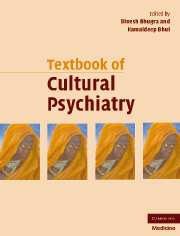Book contents
- Frontmatter
- Contents
- Contributors
- Foreword
- Preface
- Part I Theoretical background
- Part II Culture and mental health
- Part III Culture and mental disorders
- 15 Neurosis
- 16 Schizophrenia and related psychoses
- 17 Affective disorders
- 18 Substance misuse
- 19 Culture and mental disorders: suicidal behaviour
- 20 Personality disorders and culture
- 21 Culture and obsessive-compulsive disorder
- 22 Culture and eating disorders
- 23 Childhood and adolescent psychiatric disorders
- 24 Culture and schizophrenia
- 25 Disorders of ageing across cultures
- Part IV Theoretical aspects of management
- Part V Management with special groups
- Part VI Cultural research and training
- Cultural psychiatry: the past and the future
- Index
- References
17 - Affective disorders
from Part III - Culture and mental disorders
Published online by Cambridge University Press: 11 August 2009
- Frontmatter
- Contents
- Contributors
- Foreword
- Preface
- Part I Theoretical background
- Part II Culture and mental health
- Part III Culture and mental disorders
- 15 Neurosis
- 16 Schizophrenia and related psychoses
- 17 Affective disorders
- 18 Substance misuse
- 19 Culture and mental disorders: suicidal behaviour
- 20 Personality disorders and culture
- 21 Culture and obsessive-compulsive disorder
- 22 Culture and eating disorders
- 23 Childhood and adolescent psychiatric disorders
- 24 Culture and schizophrenia
- 25 Disorders of ageing across cultures
- Part IV Theoretical aspects of management
- Part V Management with special groups
- Part VI Cultural research and training
- Cultural psychiatry: the past and the future
- Index
- References
Summary
EDITORS' INTRODUCTION
Depression in particular, and affective disorders in general, are prime examplars of cultural influences on feelings and emotions. Many languages do not have words which can be applied to depression, even though feelings of sadness, unhappiness and associated biological factors have been reported from a large number of cultures and societies. The development of cultural psychiatry in the context of political and social settings indicates that constructs of illnesses or the development of research questions are linked with a number of factors which are changing regularly, from the concept of the happy native who did not suffer from depression in the 1950s to the recent multicentre studies which found that depression exists across cultures even though its prevalence and its recognition varies.
Bebbington and Cooper in their chapter provide a brief historical context in the development of cultural psychiatry. Cultures are internalized by individuals and the social response to distress is thus influenced accordingly. They propose that feeling bad (like other feelings and emotions) is related to a feedback loop with processes of social evaluation and self-comparison. These cognitions of lowered self regard and fear of future circumstances are culturally influenced and socially mediated. The use of language and somatic metaphors indicates not only cultural differences but also social class and education. Biomedical explanations may exist in different settings and interpretations of feelings of dysphoria are influenced by a number of factors. Using illustrations from different cultural settings, Bebbington and Cooper argue that cultural influences on the frequency of affective disorders are going to be influenced by processes of globalization as cultures are not impervious to external change.
- Type
- Chapter
- Information
- Textbook of Cultural Psychiatry , pp. 224 - 241Publisher: Cambridge University PressPrint publication year: 2007
References
- 5
- Cited by



